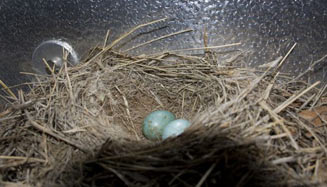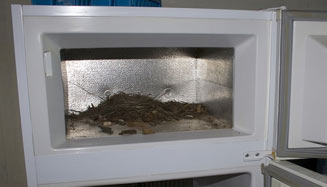|
Cercomela familiaris (Familiar chat)
Gewone spekvreter [Afrikaans]; Isikretyane, Unongungu [Xhosa]; umBexe
[Zulu]; Letlerenyane, Letleretsane [South Sotho]; Roodstaart-spekvreter
[Dutch]; Traquet familier [French]; Rostschwanzschmätzer, Rostschwanz
[German]; Chasco-familiar [Portuguese]
Life
> Eukaryotes >
Opisthokonta
> Metazoa (animals) >
Bilateria >
Deuterostomia > Chordata >
Craniata > Vertebrata (vertebrates) > Gnathostomata (jawed
vertebrates) > Teleostomi (teleost fish) > Osteichthyes (bony fish) > Class:
Sarcopterygii (lobe-finned
fish) > Stegocephalia (terrestrial
vertebrates) > Tetrapoda
(four-legged vertebrates) > Reptiliomorpha > Amniota >
Reptilia (reptiles) >
Romeriida > Diapsida > Archosauromorpha > Archosauria >
Dinosauria
(dinosaurs) > Saurischia > Theropoda (bipedal predatory dinosaurs) >
Coelurosauria > Maniraptora > Aves
(birds) > Order: Passeriformes
> Family: Muscicapidae > Genus: Cercomela
Distribution and habitat
Occurs in patches across the Sahel, with a separate
population stretching from Tanzania through southern DRC, Zambia, Angola and
Malawi to southern Africa. Here it is common across Namibia, South Africa,
Zimbabwe, south-eastern Botswana and north-western Mozambique, generally
preferring boulder-strewn mountain slopes, rocky outcrops, valley hills, open
woodland along drainage lines, woodland, farmyards and rural gardens.
|
 |
|
Distribution of Familiar chat in southern Africa,
based on statistical smoothing of the records from first SA Bird Atlas
Project (©
Animal Demography unit, University of
Cape Town; smoothing by Birgit Erni and Francesca Little). Colours range
from dark blue (most common) through to yellow (least common).
See here for the latest distribution
from the SABAP2. |
Food
It mainly eats invertebrates, which it catches using a
variety of foraging techniques, often pouncing on prey on the ground from a
perch or hawking insects aerially. It also gleans food from leaves and branches
while hovering or chasing small arthropods on the ground; it may even forage in
the intertidal zone, perching on kelps or seaweed. It often associates with
Klipspringers (Oreatragus oreatragus), catching the insects they flush or
even plucking ectoparasites from their skin The following food items have been recorded
in its diet:
- Invertebrates
- Plants
- fruit
- Scutia myrtina (Cat-thorn)
- Morus (mulberries)
- seeds
- Miscellaneous
- animal fat
- human and pet food
- road kills
- It formally used to take grease from wagon axles,
causing the Afrikaans to name it the Spekvreter.
Breeding
- The nest is constructed in about 2-13 days, consisting of an open cup of
dry grass, paper and string and lined with finer material, such as fluffy
seeds, hair, feathers and wool. It is usually built on an untidy platform of
earth clods, small stones and bits of bark, and it can be placed in a wide
variety of sites. It most commonly uses cavities in walls, buildings or
trees, old burrows of bee-eaters or other burrowing bird species, rock faces
or an artificial structure such as a nest box, shelf, letter box or even a
freezer, as seen in the photos below.
 |
 |
|
Familiar chat nest in a freezer, Rooiport Nature Reserve, South Africa. [photo
Trevor Hardaker ©] |
- Egg-laying season is usually from June-April, peaking from
August-December, although in arid regions it can breed at any time of year
in response to rainfall.
- It lays 2-4 eggs, which are incubated for about 13-15 days.
- The chicks are fed by both parents, leaving the nest after about 15-19
days.
Threats
Not threatened, in fact it has adapted quite well to
habitat disturbance caused by humans.
References
-
Hockey PAR, Dean WRJ and Ryan PG 2005. Roberts
- Birds of southern Africa, VIIth ed. The Trustees of the John Voelcker
Bird Book Fund, Cape Town.
|
